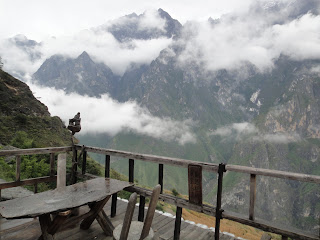We take a public bus from Lijiang to Dali. As we travel we keep catching glimpses of and crossing and re-crossing the new highway that is being built. When it is finished, the journey time between Lijiang and Dali will reduce from 4 to around 2 and a half hours. We pass through rural farming communities where the land is terraced for rice production. People working in the fields wear the traditional ‘coolie’ hats. The rice harvest is well underway and in most fields the crop has been cut and is stacked in small neat stooks. In other fields we see people cutting the rice with hand sickles.
As we approach Dali we drop down to a plain and the farm land becomes flat and the crops more varied with vegetables (some identifiable and others not) and fruit as well as rice. The land is divided by irrigation channels and small banks. The town of Dali lies of the western edge of Erhai Lake and below the Green Mountains. The 4 original gates and some of the old city walls remain. It is home to an ethnic minority called the Bai. Dali was one of the original backpacker destinations, so it is easy to find a place to serve you a banana pancake. It is another tourist destination for both Chinese and westerners. The main streets are full of souvenir shops and western restaurants with wi-fi and chinese restuarants and women dressed in traditional ethnic clothes approach the tourists trying and sell them silver hair clips and earrings.
Peggy and Katie having a beer
bar street at night
city gate at night
ingredients outside a restaurant
We have one full day here and Peggy, Katie and I decide to walk down to the edge of the lake where there is a traditional Bai village. We walk away from the city, with the mountains behind it and through flat farmland, where the rice has already been harvested. The weather is very changeable and heavy clouds and dark skies hang over the mountains, while the sun shines brightly on the lake. A whole rainbow hangs in the sky.
mountains and farmland
rainbow
We arrive at the village which is very traditional and with no tourist development in the village itself, although tourist boats come and go from the jetty here. In the small square a few local people are selling produce of fish from the lake and vegetables.stalls selling fish and vegetables
We walk down to the beautiful lake. We can see settlements on the far side and it stretches away to our left and right farther than we can see. A flotilla of tourist boats, with little pagoda-style roofs is waiting for passengers and at the end of the jetty two Chinese men have set out several fishing lines.
tourist boats waiting for tourists
Erhai lake
We walk around the streets of the village. The architecture here is different; the houses are bigger and taller and decorated externally with white-painted plaster and murals. Even the brick-pattern is painted on.
Bai houses in Caicun
painted brick pattern and flowers
mural
We reach the edge of the village and sit to rest by the side of the street. A old man and his grandson come towards us. The grandfather is friendly and smiles and says, ‘Hello, hello’. He is keen to show these strange western women to his grandson, but the boy is shy and refuses to move his feet to come closer to us and then hides behind his grandfather’s legs and under his jacket.grandfather and grandson
We catch the bus back to Dali and wander around the old town. We come across an authentic food market selling fruit and vegetables, meat and fish. We have to be discreet about the photos we take, as some of the stall holders don’t appreciate this intrusion. In one corner a man has just finished plucking a chicken and is about to gut it. Goods are weighed on a balance rod, with the item in a pan one end and a weight that is moved along the rod to find the balance point. Live fish prove problematic as they flap around, so they have a string stitched to their scales which enables them to be suspended as they are weighed.
fruit and vegetables in the market
In the meat section the counter is made of metal to keep the meat cool. Every piece of the animals seesm to be for sale. We see chickens feet; lovely looking joints of meat and unidentifiable offal.
In the evening Peggy and I check out a Chinese restaurant that is recommended in her guide book, as we are keen to try the local fish casserole. This would have been a challenge to our chop-stick abilities a couple of weeks ago, but now we are very dexterous and can separate the meat from the bones almost like the locals! All these posts seem to end with me and Peggy eating.
Peggy and fish casserole




















































